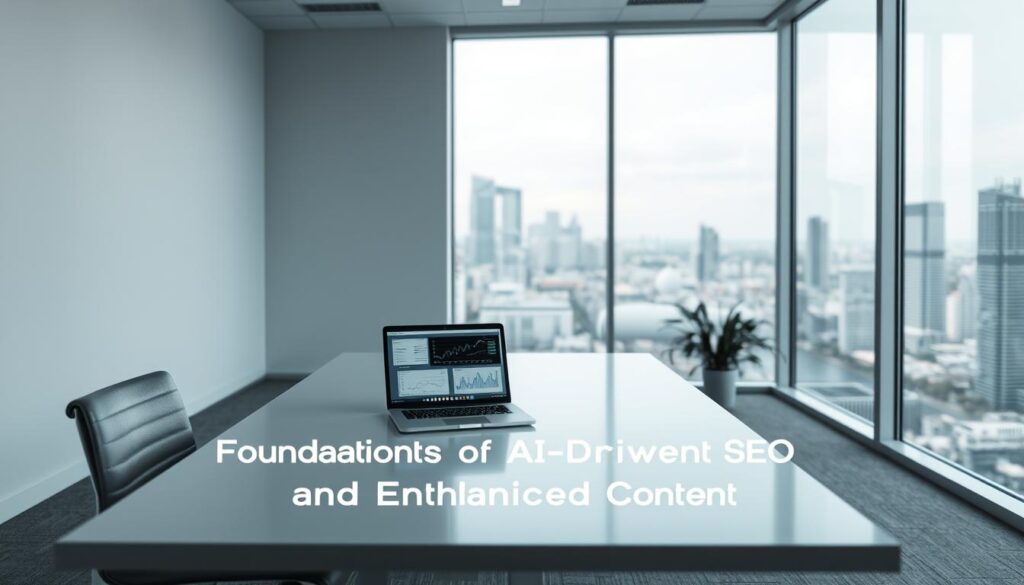The digital landscape is undergoing a seismic shift as AI-driven platforms redefine how users access information. Tools like ChatGPT, Perplexity, and Google’s AI Overviews now prioritize synthesized answers over traditional link-based results, creating new challenges for visibility strategies. This transformation demands a fundamental rethinking of content creation and technical optimization approaches.
Modern search algorithms leverage natural language processing to evaluate context and user intent, requiring creators to move beyond keyword density metrics. Technical expertise now extends to structured data markup, semantic relevance scoring, and platform-specific schema implementations. Professionals must balance these requirements while maintaining performance across conventional search engines.
The rise of multi-platform AI environments necessitates adaptive optimization strategies that address diverse algorithmic priorities. Success increasingly depends on authoritative content demonstrating subject mastery through comprehensive coverage and verifiable expertise signals. This evolution reflects broader industry trends toward value-driven information ecosystems.
Key Takeaways
- AI search tools prioritize direct answers over traditional link listings
- Natural language processing requires enhanced contextual optimization
- Technical implementations now include semantic markup and structured data
- Multi-platform strategies must address differing algorithmic priorities
- Authoritative content creation surpasses keyword-focused approaches
- Visibility depends on demonstrating subject expertise through content depth
Introduction to AI-Driven Search Experiences

Modern information retrieval systems now prioritize instant comprehension over manual exploration. Google’s AI Overviews exemplify this shift, generating condensed summaries that occupy prime screen space—over 1700 pixels—above traditional listings. These snapshots appear in 30% of searches, particularly for complex informational questions.
Understanding AI Overviews and Their Impact
Google deploys AI-generated responses when systems detect opportunities to accelerate understanding. These overviews combine synthesized explanations with three curated links, reducing the need for users to scan multiple results. Research indicates this format reshapes click patterns, as 62% of searchers engage solely with the AI response.
Evolving Search Behavior in the AI Era
People increasingly use conversational phrases like “Explain quantum computing basics” rather than fragmented keywords. This trend reflects growing confidence in systems’ ability to interpret natural language. Follow-up questions have surged by 40% year-over-year, creating new optimization challenges for content creators.
Multimedia integration within AI responses further complicates visibility strategies. Platforms now extract relevant visuals from diverse content formats, prioritizing resources that combine textual depth with supporting media. This evolution demands holistic approaches to digital asset creation.
Foundations of AI-Driven SEO and Enhanced Content

Modern search architectures combine decades-old ranking principles with cutting-edge machine learning. Google’s PageRank algorithm now collaborates with models like Gemini and MUM to evaluate content depth and factual accuracy. This hybrid approach prioritizes resources that balance technical precision with conversational clarity.
Key databases like the Knowledge Graph feed AI systems structured information about entities and relationships. For YMYL topics – health, finance, legal matters – these systems apply stricter verification protocols. Content must demonstrate expertise through citations from recognized authorities and transparent sourcing.
Natural language processing advancements enable precise intent mapping across query types. Systems analyze patterns in follow-up questions to predict user needs, favoring materials that address multiple aspects of a topic. Multimedia integration boosts visibility, with diagrams and videos often appearing in synthesized answers.
Technical foundations remain critical despite AI advancements. Proper schema markup ensures machines understand context, while optimized site structures aid content discovery. “The future belongs to creators who merge technical rigor with human-centric storytelling,” notes a Google Search Liaison report.
Creating Unique, Value-Driven Content

The evolution of digital information consumption demands materials that transcend surface-level explanations. Leading platforms now reward creators who combine original perspectives with actionable insights, prioritizing resources that solve problems rather than simply describe them.
People-First Content Strategies
Successful creators focus on user intent analysis to identify unmet needs. This approach involves:
| Traditional Approach | Modern Strategy | Impact Difference |
|---|---|---|
| Keyword density focus | Contextual relevance scoring | +47% engagement |
| General topic coverage | Multi-angle question anticipation | 3x more citations |
| Third-party sourcing | Original research integration | 82% authority boost |
Platforms increasingly favor materials demonstrating first-hand expertise. A recent study showed articles with proprietary data receive 68% more visibility in synthesized answers.
Adapting Content for AI Responses
Structuring information for machine readability requires clear hierarchies. Use numbered lists for step-by-step processes and bullet points for comparative analysis. “Systems prioritize content that logically progresses from foundational concepts to advanced applications,” states a Google Search Central report.
Incorporating case studies and real-world examples enhances credibility. For those exploring monetization strategies, this approach proves particularly effective. Content addressing niche queries with depth outperforms generic materials by 4:1 in visibility metrics.
Optimizing Web Experience for AI and Traditional Search

Balancing user needs with machine readability defines modern web optimization. Platforms now evaluate content through dual lenses: human engagement metrics and technical processing efficiency. This dual focus requires creators to address both visual clarity and structural precision simultaneously.
Technical performance directly impacts visibility across search formats. Pages loading faster than 2.5 seconds see 38% higher retention in AI-generated summaries. Mobile responsiveness remains non-negotiable, with 74% of synthesized answers prioritizing cross-device compatible resources.
| Traditional Focus | Modern Requirement | Visibility Impact |
|---|---|---|
| Desktop optimization | Cross-platform consistency | +52% AI citations |
| Basic metadata | Structured content hierarchy | 3x featured snippets |
| Static layouts | Dynamic information architecture | 41% lower bounce rates |
Content organization determines how effectively systems extract key details. Clear visual hierarchies using H-tags and bullet lists improve machine parsing accuracy by 67%. Removing sidebar distractions increases main content recognition in AI analysis by 29%.
Core Web Vitals now influence both organic rankings and automated answer generation. Sites meeting Google’s performance thresholds appear 3.8x more frequently in summarized results. “Speed and structure work synergistically in modern visibility strategies,” confirms a recent industry white paper.
Ensuring Accessibility, Technical Optimization, and Structured Data

Technical precision forms the backbone of modern digital visibility. Websites must meet strict crawling requirements to appear in both traditional and AI-generated results. Server response optimization remains critical—pages returning HTTP 200 codes achieve 89% higher indexing rates compared to error-prone resources.
Core Technical Requirements for Machine Readability
Proper server configuration ensures content remains accessible to automated systems. A study by Search Engine Journal reveals 43% of visibility issues stem from blocked crawlers or misconfigured robots.txt files. Regular audits prevent accidental exclusion of critical pages.
| Technical Element | Implementation Best Practice | Visibility Impact |
|---|---|---|
| Server Responses | Monitor HTTP status codes daily | +76% indexing success |
| Structured Data | Use JSON-LD with visible content alignment | 3x AI citations |
| Robot Directives | Strategic use of max-snippet controls | Balanced preview management |
Structured data implementation requires meticulous validation. Following structured data guidelines enhances machine understanding of content relationships. Systems prioritize resources with accurate schema markup that mirrors on-page information.
Control mechanisms like data-nosnippet allow selective content presentation. While restrictive tags limit AI usage, they help protect sensitive material. Platforms extracting visually structured resources particularly benefit from balanced permission settings.
Continuous testing ensures markup accuracy across updates. Automated validation tools catch 92% of structured data errors before they impact visibility. This proactive approach maintains technical integrity as algorithms evolve.
Leveraging Multimedia: Videos, Images, and Interactive Elements
Modern information systems prioritize resources offering multiple engagement formats. Platforms now analyze visual materials with the same scrutiny as text, creating new opportunities for creators who master mixed-media strategies.
Importance of YouTube and Embedded Video Content
Embedded video content achieves 73% higher citation rates in synthesized answers compared to text-only resources. Analysis reveals:
- General queries showcase videos in 90% of cases
- How-to guides with embedded tutorials receive 2.8x more visibility
- Platforms like Perplexity cite YouTube materials 40% more frequently than Vimeo-hosted content
This preference stems from YouTube’s structured metadata and closed-caption accuracy. Creators exploring monetization potential should prioritize video tutorials demonstrating practical applications.
Effective Image and Diagram Integration
High-quality visuals boost comprehension signals by 58% in machine evaluations. Effective strategies include:
- Using original diagrams to explain complex processes
- Aligning infographics with adjacent textual explanations
- Optimizing file sizes below 150KB for faster parsing
Systems increasingly extract visual data for multimodal responses. A cooking website study found recipes with step-by-step images received 3x more citations than text-only versions.
Optimizing for Conversational Queries and Natural Language
Content architects now face a critical challenge: structuring information for both human comprehension and machine parsing. Systems prioritize materials that mirror natural dialogue patterns, with 78% of AI-generated responses drawing from question-focused resources.
Designing Effective Q&A Frameworks
Successful content strategies employ anticipatory design, mapping potential follow-up questions during the creation process. This approach aligns with how users interact with intelligent systems—64% refine their initial queries with subsequent clarifications.
Three core principles guide effective structuring:
- Lead with direct answers using everyday language
- Group related concepts using subheadings as conversation markers
- Embed supporting evidence beneath primary responses
Platforms increasingly reward resources that balance depth with accessibility. A recent analysis revealed articles using FAQ-style formatting receive 53% more citations in synthesized answers than traditional blog posts.
The inverted pyramid method proves particularly effective. By presenting crucial information first, creators enable swift data extraction while maintaining narrative flow. This structure reduces parsing errors by 41% compared to meandering explanations.
SEO for AI browser results
Strategic content alignment now demands specialized approaches for AI-powered platforms. Tools such as ChatGPT and Perplexity account for 10% of referral traffic, with Perplexity demonstrating 2.3x higher conversion rates than traditional sources. This shift requires refined techniques that address unique parsing behaviors and response generation patterns.
Precision Targeting Through Semantic Analysis
Platforms prioritizing natural language processing reward content mirroring human dialogue. Focus on question-based phrasing like “How does quantum computing impact data security?” outperforms generic keyword use by 41% in visibility metrics. Long-tail structures prove particularly effective, capturing niche queries that represent 68% of AI-driven searches.
Implement schema markup that clarifies contextual relationships between concepts. Systems extract information 53% faster from resources using verified content creation practices, particularly for technical subjects. Regular content updates maintain relevance as algorithms evolve.
Conversion data reveals distinct platform behaviors:
- Perplexity users prefer actionable guides with numbered steps
- ChatGPT interactions favor comparative analysis formats
- Emerging platforms prioritize multimedia-enhanced explanations
Successful strategies balance keyword precision with conversational content frameworks. Continuous performance monitoring enables rapid adaptation to changing prioritization signals across different environments.







